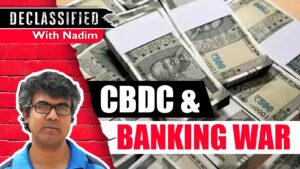 By Nadim Siraj
By Nadim Siraj
April 1, 2022: A decision taken by Vladimir Putin’s government this week amid the fighting in Ukraine has shaken the foundations of the little-discussed petrodollar empire – a monopolistic dollars-for-oil arrangement that keeps the US currency perpetually in high demand.
In retaliation to the West and its allies for slapping economic sanctions on Russia for invading Ukraine, Moscow has declared that from this summer, its critics can buy gas from Russia only in exchange for roubles – dollar payments are no longer welcome.
On Friday, Putin signed a decree declaring that purchasers “must open rouble accounts in Russian banks” in order to continue buying Russian gas. “If such payments are not made, we will consider this a default on the part of buyers, with all the ensuing consequences. Nobody sells us anything for free, and we are not going to do charity either – that is, existing contracts will be stopped,” the Russian leader threatened.

All 27 European Union nations, along with US, Britain, Australia, Canada and Singapore, are on a list of at least 45 critics-of-Putin countries who will have to pay in roubles for importing Russian gas. The new system is likely to come into effect in May this year.
According to the arrangement, the terms and conditions of existing contracts will remain the same, except for the mode of payment. Buyers of Russian gas will first have to open an account with Russia’s Gazprombank and transfer euros or US dollars into it. Next, the bank will convert that money into roubles, which will then be used to make the payment for the gas being purchased.
The popular and influential press in the West has slammed Russia’s roubles-only mandate, pointing to Moscow’s ambitions to launch what could go on to be dubbed as the ‘petrorouble’ – exactly along the lines of the US petrodollar.
In Paris, the finance minister said France along with Germany were preparing for a scenario in which gas flows from Russia could be frozen – a development that has the potential to sink entire Europe into a major energy crisis.
DISCOUNTED OIL FOR INDIA
At the same time, India, a traditional ally of Russia on multiple fronts, is considering a long-term rupee-rouble payment system for trade with Moscow. If agreed upon, it is likely that the Russian government could offer India oil at discounted prices.
If the plan materialises, it could see the US dollar losing its foothold in trade between India and Russia. A similar arrangement already exists between Russia and China, who are nowadays consistently trading in gold, euros and other currencies, while strictly avoiding the US dollar for transactions.
To many people, Russia’s anti-dollar move may seem like a kneejerk reaction. But it bears grave implications for the hugely powerful and monopolistic greenback. If governments relying on Russian gas and oil start paying Moscow for it only in roubles, the dollar’s demand and worth on the international market could steadily weaken. That, in turn, could permanently loosen America’s firm grip on the global economy.
While the Western press is reporting on Russia’s roubles-only decision as draconian and one-sided, it has sidestepped the dark history of the petrodollar system, which dwarfs the new Russian plan.
THE PETRODOLLAR COMPULSION
The petrodollar has been the key to American supremacy in West Asia. The petrodollar system helps us understand why the US military machine pursues a state of perpetual domination in the region. It is why there is uncompromising backing for unelected dictatorial regimes in the Gulf countries.
Over the past decades, we have all witnessed ‘how’ the US-led West intervenes in West Asia to control oil resources. The petrodollar story tells us the real story behind that ‘how’ — ‘why’ the Western governments and foreign energy corporates are desperate to stamp their authority over the region’s oil resources.
It is necessary to first understand the term ‘petrodollar’. Ever since the mid-1970s, the oil-rich West Asian and North African nations (the OPEC cartel), have been following an unusual, monopolistic directive from Washington, DC. As per the directive, these countries must sell their crude oil to various national governments in exchange for only US dollars.
After selling their crude oil for dollars, these oil nations are compelled by the US to buy American treasury bills and stocks with that money. So, the dollars earned by the West Asian Big Oil nations travel westwards and get parked in top American banks. In turn, those phenomenal sums of oil money (that travel from West Asia to US banks), are reinvested into the US economy and a few other Western economies, leading to their economic survival.
To understand why the US government deems the petrodollar system sacrosanct, one must understand this.
All oil-buying nations desperately require dollars to buy oil from the oil-producing countries, and this worldwide demand keeps the US currency permanently buoyant and dominant. This, in turn, places Washington, DC, the US Federal Reserve and the country’s economy in a perennially commanding position to dictate terms. One can say that nations that procure crude oil are generally at the mercy of the US, since they have a constant and desperate need to stockpile American currency, whether they like it or not.
This dollar-for-petroleum money earned by the oil-producing nations is called petrodollar, and the procedure of investing the oil money into the US is called ‘petrodollar recycling’. The system is now common knowledge. But what is not common knowledge are the shadowy circumstances in which the petrodollar was born in 1974, underlining an American masterstroke to inflate worldwide demand for the dollar.
1974: THE DOLLAR IS REBORN
The petrodollar’s fascinating origin is widely written about in the media and is well documented by historians. The system was best exposed in an article published by Bloomberg on 31st May, 2016 (The Untold Story Behind Saudi Arabia’s 41-year US Debt Secret).
Journalist Andrea Wong wrote that in July 1974, the then US President, Richard Nixon, sent William Simon, the then US Treasury Secretary, along with his second-in-command, Gerry Parsky, on a discreet trip to Jeddah, to strike a formal deal with the Saudi Arabian royal family, represented at the time by King Faisal Al Saud (who was assassinated on 25th March, 1975).
The deal was struck between the Saudi central bank, known as SAMA (Saudi Arabian Monetary Authority), and the US Treasury Department. Henry Kissinger, the US Secretary of State at the time, kept a close watch on proceedings as the deal was formalised. The crux of that US-Saudi agreement was a game-changing move and monopolistic in nature.
As per the article, the story unfolded like this. The US government would import a steady, substantial, and agreed-upon quantity of Saudi Arabian crude oil. In return, the US government would give the Sunni, pro-Wahhabi monarchy fool-proof military support as protection against Israel, a militarily well-equipped opponent in Saudi Arabia’s backyard. Crucially, for all the crude the monarchy would peddle to countless nations all over the world, it would accept payment only in greenbacks.
The Saudi Arabian government would then inject over half of the oil-trade profits into the US economy (and partly into the British economy as well). The inflow of dollars into US banks, earned from the Saudi sale of oil, would benefit the US on two fronts — easing the ballooning US debt, and funding US military spending.
In the months following the emergence of the petrodollar, the ruling family in Riyadh and the US government persuaded OPEC countries to switch to the dollars-only arrangement, by mid-1975. The development resulted in spiraling demand for US currency among most of the governments all over the world because the greenback became the only mode of payment for crude oil purchases from the OPEC suppliers.
In the 1988 book, Western Expansionism in the Persian Gulf, Russian diplomat Viktor Leonovich Mikhin, quotes a Newsweek article to claim that this petrodollar set-up included a pledge from King Khalid of Saudi Arabia that his government would invest 50% of its oil profits in US treasury bonds. Mikhin reveals that, ‘…by investing 50% of its active balance in US bonds paying 7.5% [interest] for a 25-year term, Saudi Arabia was helping out the US credit and finance system, which was constantly suffering from a deficit.’
In return, Saudi Arabia was given the ‘right’ to use the interest to purchase expensive weaponry and military hardware, exposes Mikhin in his work. In addition, says the writer, the US promised to ‘provide the Saudi Arabians with military cover’, in the event of any threat that might arise in its backyard — basically from Israel.
SADDAM VS PETRODOLLAR
The US and its banks made the most of the oil-for-greenback system right up to the early 2000s. But after that, the tide slowly started to turn. In an apt reminder of Bob Dylan’s timeless classic, The Times They Are A-Changin’, a small but significant rebellion began brewing against the monopoly of the dollar.
The euro, Europe’s common currency, was already in circulation by then and the Chinese yuan was steadily gaining ground. After years of monopolistic dominance, the US currency was no longer the pet favourite of the Big Oil producers as it had been from the mid-1970s to the early 2000s.
Headed by Saddam Hussein, the Iraqi government was the first country to put its hand up against the dollars-only arrangement.
Saddam, a friend-turned-foe of the US government and a dictator with a poor human rights record, courageously announced that his country would detach its oil business from the petrodollar compulsion. In 2000, Saddam began airing his intentions to sell Iraqi oil globally only in exchange for euros, not dollars.
Soon after, Iraq, a country with a decently healthy economy and at the time primarily a socialist nation, was crippled by the onset of brutal, US-instigated economic sanctions. The debilitating sanctions were followed by America’s urge to invade Iraq in a bid to remove Saddam from power. In 2003, Iraq was invaded for its never-to-be-proven connections to the 9/11 terrorist strikes in the US and the never-to-be-found stockpiles of WMDs, as wrongfully claimed by Tony Blair and George Bush Jr.
Saddam was eliminated and his last moments were advertised via the mainstream press as a warning to other oil-producing countries. It is important to remember here that Saddam was once viewed by Washington, DC as a staunch ally.
It is also interesting to note that since the fall of Iraq, the country’s new administration has been trading its crude oil only for dollars — a fact not highlighted by the corporate media. The toppling of Saddam and his Ba’ath Party ensured that plans to challenge the petrodollar in Iraq were shelved.
GADDAFI VS PETRODOLLAR
After Iraq came the turn of Libya, whose leader, Muammar Gaddafi, announced plans of launching a pan-African, gold-backed currency, popularly hailed as the ‘gold dinar’, during the mid-2000s. Basically, Gaddafi was planning to do a Saddam — move away from the petrodollar.
In an article published in The Guardian on 21st April, 2011 (Libya: Another Neocon War), journalist David Swanson wrote that, as per Gaddafi’s audacious proposal, Libya wanted to sell its oil only for the newly-planned currency. The Libyan boss wanted the proposed gold dinar to become the common African currency. The result of that independent plan? Libya spun into chaos, thanks to the 2010–2012 Arab Spring revolutions and the subsequent foreign intervention.
Hounded by NATO-backed forces, Gaddafi was knocked off following an airstrike in 2011, and the North African nation became unstable. It is needless to add here that Libya was forced to jettison the gold dinar dreams. The petrodollar survived the threatening Gaddafi storm in Libya.
(For a detailed throwback into the origin of crude oil politics and Iran-US tensions, you may catch a copy of Secret Notes from Iran: Diary Of An Undercover Journalist)
REPUBLISH! Feel free to republish this article/video on the following terms: (1) Use the writer’s credit/byline at the start, (2) Hyperlink this post, (3) Mention our website EmpireDiaries.com with a hyperlink.









